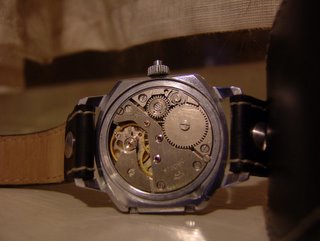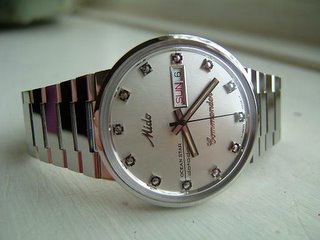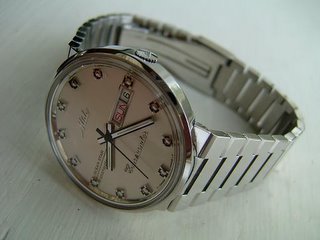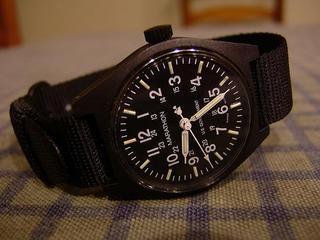
A typical late model Zim Pobeda movement. Note the complete lack of finishing.


A pair of new new ZIM Pobedas
 A First Moscow Watch Factory Pobeda. This one was an award watch with an inscribed dedication on the back.
A First Moscow Watch Factory Pobeda. This one was an award watch with an inscribed dedication on the back.

The ZIM Pobeda on a bund strap




 A First Moscow Watch Factory Pobeda. This one was an award watch with an inscribed dedication on the back.
A First Moscow Watch Factory Pobeda. This one was an award watch with an inscribed dedication on the back.


If a watch can be said to be the Timex of Russia, I think the Pobeda is it. In the years immediately following the Second World War, the Soviet government found itself in need of a more modern timepiece than the old Type One (reviewed below). With this in mind, some sort of deal was struck with the French watchmaker Lip for the production of a men's wristwatch based on the Lip r26 movement. (For more on Lip see) The result was named Pobeda, meaning victory in Russian (named for obvious reasons). In a curious bit of historical trivia, the name Pobeda was supposedly chosen by Stalin himself (see this page at poljotwatch.com).
Initially, production of the Pobeda was only done at the First Moscow Watch Factory, but after a few years, the Second Moscow Watch Factory, the Petrodvoretz factory, the Maslennikov (ZIM) factory and the Vostok factory were producing the movement as well. The various factories made a number of modifications to the movement over the years including adding jewels, replacing the sub dial with a central second hand, and adding a hacking feature. The Pobeda has a reputation for being a very durable watch and the movement was still in production until recently by the ZIM factory. It should be noted that in terms of both quality and desirability, Pobedas made by the First Moscow Watch Factory are considered the best, while the ZIM examples are considered the least collectable. Indeed, the latter examples of ZIM movements have a crude, unfinished look about them, unlike the earlier models that had such touches as Geneva stripes and engine turned finishes.
Of the three examples shown here, the one with the engraved back was made by the First Moscow Watch Factory in 1955 and the other white-faced model was made in the mid-fifties by the Petrodvoretz factory outside St. Petersburg (later to be renamed the Raketa factory after the Sputnik launch). The black model is an early ZIM, also from the fifties I believe. All three are examples of the original style Pobedas with sub dial second hands. They use acrylic crystals and have no lume. The Pobeda movement is a 15 or 16-jewel hand wound type whose accuracy seems to be in the +/- 40-second range although that can be improved on with regulation. Most Pobedas are smaller, traditionally sized, watches of 33mm and 35mm sizes but prior to the bankruptcy of the ZIM factory in the early 2000's, some 38mm Pobedas were made with mineral crystals. Update-The second from the top picture is a newly acquired Pobeda made in 2004, shortly before the ZIM factory went into bankruptcy. The watch has 18mm lugs and a mineral glass crystal but is otherwise ver similar to the other Pobedas. The case measures 36mm including the crown and the movement is completely undecorated. Above that is another NOS model. It too has 18mm lugs but uses an acrylic crystal like the older Pobedas. Cost me all of $13.
I mentioned that I considered the Pobeda a Russian Timex. The reason I feel this way is entirely a matter of price. Whether the model you are looking at is new old stock or a vintage model from fifty or so years ago, you would be hard pressed to spend more than thirty dollars on a Pobeda. They are about the least expensive mechanical watches I have encountered. I can easily spend more cash on lunch then a Pobeda would run me. The black model pictured here cost me all of nine dollars while its white counterpart set me back a whopping twenty-two dollars. (Pobedas are widely available on ebay. One seller, Zenitar, has a good assortment of inexpensive new old stock models to choose from. Look under the catagory-Other watches. Older models are available from a variety of different sellers.) Now low price is all well and good of course, provided the watch is not a piece of junk. Fortunately, that is not the case with the Pobeda. While no one is about to confuse one with an Omega, a Pobeda does get the job done well without any fuss. The ZIM model here needed regulating when I got it (it clearly had led a pretty hard life) but now is accurate to about 20 seconds a day. The white-faced Petrodvoretz Pobeda needed nothing when I got it, running at about +15 seconds daily. For a pair of inexpensive 50+-year-old watches with little pretension between them, that's not a bad deal at all.
Note-No discussion of the Pobeda would be complete without mentioning Andrew Babanin's fine review over at Timezone.




The Raketa Braille watch is, as its name implies, a watch that is primarily meant for the visually impaired. That being said, however, it can be used like any other watch as well. The watch was manufactured at the Petrodvoretz factory outside of
.
The Braille watch appears to use a chrome plated case with a snap-on stainless steel back. The case measures 38mm wide at its widest point (diagonally) and is 34mm directly across the face (37mm with the crown). Additionally, the lug width is 18mm. The movement is Raketa's 17 jewel hand wound 2601. The watch is not at all water resistant, a fairly common issue with Raketas. To use the Braille function, a button on the crown releases a spring loaded hinge holding the crystal. The watch hands are made of thick steel and can be handled without fear of bending them. For this reason, there is no second hand. Lastly, the watch face has raised markers to allow reading by touch. It takes a bit of getting used to but the whole thing works quite well. The watch has no lume however.
.
I personally find the Raketa to be an attractive and well built mechanical watch. I cannot comment on its precise accuracy as the watch lacks a second hand, but it seems to be good to about a minute or so per week which is really just fine. I particularly appreciate how this watch does not loudly advertise its specialized function. It really looks no different from most other watches and if you didn't already know that this was a watch for the blind, you probably would not guess it. That sort of elegance in design is something that seems sorely lacking to my eye when it comes to products meant for people with disabilities. The fact that the intended user of this watch might never be able to see it is no excuse for making it ugly. Fortunately, Raketa made no such mistake.
 A newly acquired Type One. This one is from the First Moscow Watch Factory. It has 15 jewels and was made in 1938. The crown is not original but, otherwise, everything works well. The dial on this one was probably repainted in 1955 in commemoration of the first Soviet mission to the South Pole.
A newly acquired Type One. This one is from the First Moscow Watch Factory. It has 15 jewels and was made in 1938. The crown is not original but, otherwise, everything works well. The dial on this one was probably repainted in 1955 in commemoration of the first Soviet mission to the South Pole.


I decided to write this review for the fun of it more than anything else. (Note-I had originally titled this review First Moscow Watch Factory Type One. An astute reader at the Watchuseek Russian Watch Forum noted that it was in fact made by the First State Watch Factory, a precurser to the First Moscow Watch Factory. I love knowing these little details. Many thanks.) The Type One, also variously referred to as K-43 and Kirova hasn't been made since the late 40's as far as I know. It is a very interesting watch, however, at least to collectors of Russian watches. This particular model was the first domestically produced watch in Russia. Prior to making the Type One, watch making in Russia was limited to assembling foreign made parts only. Brands such as Mozer and Pavel Bure were made this way. By the late 1920s though, the Russian government saw the need for a domestic watch industry. The story of how Russia acquired this industry is told in the book, "From Springfield to Moscow: The Complete Dueber-Hampden Story" by James Gibbs. (See also here and here as well) (This book is a must read for fans of Russian watches by the way. It even has a copy of the court order authorizing the sale of the company. I have posted the first few pages of the order. If you want the whole thing, let me know and I'll email it to you. ) The book tells the story, from start to finish, of the American Dueber-Hampden watch company. Dueber was bought by the Amtorg Trading Corporation, the foreign purchasing arm of the Soviet government, in 1928 after it had gone out of business in the United States (see here). The factory was then boxed up and shipped to Russia where it was re-assembled and gotten up and running with the help of the company's former employees from the United States. The Americans who went to Russia for this project were tasked not only with making the machinery work but also with training Russian workers in the art of watch making. It seems hard to believe at first that the U.S. and Russia would cooperate this way but it should be recalled that the cold war was decades away and the abuses of the Soviet government were not yet widely known. In any event, the undertaking was evidently successful as watches like the model pictured above were manufactured in quantity.
The Type One itself is really a pocket watch with a set of 14mm lugs welded on to the case to hold a trench watch style watchband. Remarkably, despite the passage of sixty or seventy years (and the very crude look of the movement), the mainspring is still strong and the watch keeps time well. The movement in this example has only seven jewels but there was a fifteen-jewel model made too. (It is my understanding that this Dueber-Hampden movement was used in the giant Zlatoust diver watch, and either is still being produced or was until recently.)
Physically, the Type One is huge for a wristwatch. It measures 45mm in width (49mm with the big onion crown) and 14mm in height. The narrow band makes the watch look and wear even bigger. Like many timepieces of this era, water resistance is non-existent. This particular example has obviously had its dial painted long after it was built. (The KGB did not exist until the mid nineteen-fifties and the watch is older than that. A member on the Poor Man's Watch Forum commented that this particular example is a KGB award watch so maybe it is supposed to look this way now. I'm personally not sure and will probably never be.)
The Type One never fails to draw comments. It has an old-fashioned and unique look to it that you just don't see these days. I can't imagine wearing this one on a daily basis at all but it does make for nice change of pace from time to time. It also makes me think about how strange the world can be. An American watch, manufactured in Russia with the consent of the U.S. and Soviet governments. Amazing.




One of the downsides of collecting watches is the price of admission. While it�s true that there are a lot of truly fine poor man's watches out there (and there are folks who can convincingly argue that some examples of these bargain models match their pricier counterparts in all respects), the big names don't come cheap. You like Rolex, Omega, Tag Heuer, etc., bring money and lots of it. A cheap example of one of these will set you back at least six or seven hundred dollars (and that for a quartz model no less), while the good stuff is well up into the thousands of dollars. If, like me, you just don't have that kind of cash to throw around, (my kids and my money go private school), the situation could get really depressing. Fortunately, there is another way go. Take a deep breath, step back and consider the used watch market, or if you like the classier term, vintage market (to make it sound a little less like buying a used car).
It should be noted that even in the vintage market, some brands hold their value so well that there are few bargains to be had. If you are expecting a Rolex for $200 you will be sorely disappointed. Other brands, however, are very reasonably priced and if you take your time and look around, you can do very well. A few words of caution, however. The fact that a watch is old does not mean that it isn't a fake. The reality is that there are fake vintage watches out there (Seamaster 300 fakes aren't uncommon) and it isn't hard to mistake one for the genuine article. Similarly, there are a lot of so-called frankenwatches (a seemingly acceptable watch that is actually an amalgam of several other watches) floating around. The bottom line is that you should make a point of learning something about the vintage watch you are interested in. With the amount of available data online (Omega, for instance, has an online database of its vintage watches and movements) and the existence of enthusiast forums where one can ask an expert a question, researching a vintage watch isn't terribly hard anymore. Other caveats with a vintage watch, don't assume that the water resistance is functioning and expect the lume to be burnt out. Lastly, make sure that you have access to a competent watchmaker. It is reasonable to expect that a vintage watch will need a cleaning if nothing else. If all of this is too much for you, stick with new watches (not that there aren't plenty of fakes there either though).
On to the Omega. This particular model is a 1966 Seamaster DeVille. It is powered by a model 611 hand wound movement with a date display. The watch is a traditional sized man's watch, small by today�s standard at 35mm (including the crown) but it still looks quite good. The watchcase is Omega's Unishell design that opens only through the dial side which can make servicing tricky. The crystal is an acrylic one that fortunately was not scratched. The watchband is a Hadley-Roma that I added for about $25. The Omega was very clean when I got it, and when opened, it had a jeweler's date mark on the inside of the case indicating a servicing had been done two years ago. Not surprisingly, the original lume was not functioning.
The only substantial change that I made to this Omega, aside from adding a strap, was to have the lume re-done by Kent Parks at Everest Watchworks. A non-operative lume on a watch just plain bothers me and
Now none of this would really mean much if I had paid through the nose for this Omega. That, thankfully, was not the case. The total bill for the watch, the re-lume, the new band and a thorough look-see by my jeweler came to about $250. All told a good deal.





When it comes to watches, I like classic designs but still want something that doesn't mimic every other watch available. Too many classic/vintage style timepieces seem to be copying the look of a Rolex Submariner or Datejust or that of an Omega Speedmaster or Seamaster in my opinion. What initially drew my eye to the Mido Commander is how different it looks from just about every other watch I've seen, while still looking like a vintage design. The Mido has a style all its own that brings to my mind images of ocean liner travel and art-deco decor. The watch face, its most striking feature, has a sort of brushed starburst pattern that radiates up from the 6 o'clock position and the hour markers and hands have a very unusual retro look about them. I could see this watch fitting in perfecly in that old movie Metropolis. Like it or not, you must admit that this is a design that you are not likely to see everywhere you go.
-
Mido is not aggressively marketed in the United States anymore and, I'm sure, most people are not familiar with the brand. The company was founded by George Schaeren in 1918 in Biel, Switzerland. Mido has produced a number of technically interesting designs through the years including being the first to combine an automatic movement with anti-shock protection, water resistance and anti-magnetic protection. Mido also is the only company, to my knowledge, that makes use of cork as a crown water seal, and was the first company to use an unbreakable mainspring. Today, Mido is part of the Swatch Group, but the brand still retains much of its old, unique character. For a history of Mido, see this page at Swiss Watches USA.
_
My Mido Commander was NOS (new old stock, from the mid 1990's I think) and I don't believe the exact model is still available new. The current iteration uses Superluminova lume where my model uses tritium laced paint. Aside from that though, I believe the current and older models are the same. The watch is made of a polished stainless steel one-piece case with an integrated stainless steel bracelet and clasp. The crystal is made of Hesalite, a brand name for acrylic. The movement is protected from water damage by Mido's Aquadura cork crown seal (which allegedly will block water even with the crown pulled out in the set position) and is rated at 30 meters water resistance. Internally, the watch is powered by an ETA 2836-2 25 jewel automatic movement that both hacks and handwinds. (The 2836-2 is a variation on ETA's ubiquitous 2824-2 with the addition of a day wheel)
_
All told, I really like this watch. The bracelet is one of the most comfortable I have encountered and the big face is easy to read. Furthermore, and this is admittedly a matter of taste, I think the Commander is an extremely elegant design. The Mido has, so far, proved to be very accurate for a mechanical watch averaging -2 seconds per day. My only gripe is the small crown which is tricky to use. This is a minor quibble in an automatic watch however. It�s not like you have to manually wind the thing. It should be noted that the Commander's one-piece case makes servicing tricky (everything comes out through the crystal) but the watch's superior sealing might cut down the frequency of service a bit. Additionally, this Mido collects fingerprints easily. The new version of the Commander currently sells online for between $450 and $600 dollars (see example ). However, my NOS model can be found on ebay nowadays (at least for the moment) for less than $200. Not bad for nice Swiss automatic.
Some of the best deals available are vintage watches. If you are willing to overlook a scuff or scratch here and there and, maybe, put a few dollars into maintenance, some seriously good stuff can be had.
--
Sent from my Treo



The subject of this review, the Marathon General Purpose Watch (talk about a generic name for a watch) is the first genuine military watch that I have owned. As it name implies it is manufactured by the Marathon Watch Company, a Canadian business that supplies watches to the U.S. and Canadian militaries and SAR (search and rescue) teams. It is my understanding that Marathon is currently the only official supplier of watches to the American armed forces. This particular model was made for the U.S. Army in March of 2005.
The watch itself doesn't look very impressive at first blush. It is a traditionally sized man's watch, which is to say rather small by today's standards. The watch measures 34mm in width (36mm if you include the crown) and comes stock with a 16mm wide nylon, one-piece band on fixed wire lugs. The case is made of some kind of supposedly durable plastic and uses an acrylic crystal. The watch is all black except for the markings on the dial, which also has the words U.S. Government and Swiss Made printed on it. In addition to its small size, the Marathon is also extremely light. If making a big visual impression with your watch is important to you, look elsewhere, this one isn't for you. Lastly, my model uses an ISA1198 Swiss quartz movement with an easily accessible, user replaceable battery.
The Marathon General Purpose does have a number of redeeming features, however, that make it one of my favorite watches of late. The watch's best feature is its lume. The Marathon uses tritium tubes (tiny glass tubes filled with gaseous tritium) on its hands and face to provide a steady bright glow that won't fade for over a dozen years. Unlike conventional glow in the dark technology, tritium lume watches do not need to be exposed to light to charge up the glow. In this respect the watch is like Luminox, Traser and Ball brand watches except that the Marathon is significantly less expensive than those brands. The lume, as those people who own tritium lume watches know, is simply terrific. In darkness and even low light conditions the watch is very easy to see and the glow does not fade over a few hours like a conventional, light charged lume system. For those of you who are concerned about exposure to radiation, the radiation output of the tritium tubes in the Marathon is very low. It is so low, in fact, that it is said that the radiation that the tritium emits cannot even penetrate the watch�s case or crystal. Unlike older watches with industrial radium lume (some of which were dangerously radioactive), there is apparently almost no possibility of exposure to dangerous radiation with tritium tube watches. The other feature of the Marathon that makes it a keeper to me is its ruggedness. The watch is built to meet a set of standards set by the armed forces (see also here) to ensure that it will continue to work under rough field conditions. It is thus unlikely that anything that I can throw at it in my day-to-day activities will cause any permanent damage. That makes wearing the Marathon a no-brainer in my opinion. It is the perfect beater. It is also the least expensive tritium lume watch that I have been able to find, other than closeouts on ebay. (It should be noted that when shopping for a watch with tritium lume, newer is always better. Tritium has a relatively short half-life as radioactive isotopes go, and the glow from a watch with this technology will last for only twelve to fifteen years. An older model, while probably less expensive than a new piece, will not work as well or as long.)
To sum up, if you are interested in a tritium lume watch, and don�t want to spend a lot, give this Marathon a long look. It isn�t pretty in any way but it is very light and comfortable and the sheer utility and ease of use that it provides make it the perfect choice for field wear or just general knock around. Add to that its military origin, which makes it historically interesting in my opinion, and you have a winner that you will want to wear for a long time.